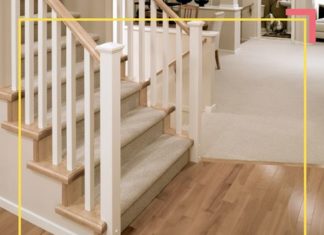
Engineered floors are the fastest growing segment of the flooring market, and for good reason. They are more stable, they are engineered to fit, snap or lock together, and in most cases, they are pre-finished. So when you’re installation is done, you’re finished! No sanding, staining, and finishing – each step requiring hours and days for drying – is required on pre-finished floors. No wonder they are so popular!
Floating Floors
The beauty of floating floors is that they lock or glue together at their edges, but do not require adhesion to the subfloor with adhesive or nails. Rather a floating floor “floats” on a cushioned underlayment designed specifically for this application. Glue together styles have faded in popularity due to the mess they created as they are blocked and tapped together, spreading the glue on the nice finished surface. Click together or “Lock and Fold” style of engineered flooring has leapt to the forefront, and it’s hard to argue with the ease of installation.
Just like solid flooring, you may need a little “persuasion” to get the pieces to marry and lock. Using a tapping block and hammer, you tap the pieces into place. Start at the longest wall that is parallel to the direction of the layout, and put a few spare pieces of flooring scrap along the edges, thereby creating an expansion gap. It’s imperative that you get all of your flooring pieces squarely locked together, or the gaps will haunt the rest of the installation.
The main attractions with floating floors are easier installation, no glues or adhesives, and the ability to cover a subfloor that may be substandard, have many layers, or even covering asbestos. Because the floor rests on a cushioned pad, they are comfortable when standing for long periods. Some criticism is directed toward floating floors due to this same softer – some describe as “squishy” – feeling underfoot. One can create a more solid feeling floating floor by utilizing a better grade underlayment and using premium, thicker flooring, both of which will lend a more solid surface.
The most important consideration with a floating floor installation is to provide enough room at the edges for expansion. Since the floor is “locked” together as one piece, it needs to have room to swell or buckling will occur. Leave room at the edges and any solid or fixed objects the flooring intersects with. Quarter round or base molding will cover the gap, so you’ll still have a neat appearance.
Glue Down Hardwood Floors
For our purposes we’ll say you are installing an engineered floor over a concrete slab at grade and that all moisture problems have been addressed. Snap a straight line out about 10 or 11 plank widths, (figuring a 3 ¼ width plank, plus 3/8” for your expansion gap at the edge) from the longest parallel wall and start your installation.
Trowel your flooring adhesive back toward the wall and spread evenly according to manufacturer’s instructions. Tap your first board into place tightly against the chalk line and few pieces of scrap flooring which you’ve nailed or glued to the concrete at the edge of the chalkline. These scraps give you something to work against, and when you’ve completed this section, you’ll simply remove them. Work toward the wall, tapping each piece into place, always checking back to your earlier work, as boards like to wriggle free if no one is looking!
Be extremely careful with flooring glue, as it can get on everything. Clean up drips and blobs with a damp rag immediately – especially on the finish surface of your new flooring! Mineral spirits may work well here, but please test first on a scrap of the pre-finished material!
Once you’ve laid the flooring from your chalkline to the wall, now you can work from the other direction, from your chalkline toward the other wall. You may want to give the adhesive time to setup and give you a more solid surface to kneel on, (don’t forget soft, padded kneepads!) Remember when using a tapping block to be aware of the tongue and groove or snap-lock edge and be careful not to damage that, or to scuff the finish for that matter.
Nailed Hardwood Floors
Probably the most common, and certainly the oldest method of attaching flooring to the subfloor, nailing or stapling is a tried and true installation technique. Create a control line toward the middle of the room measuring out from the longest parallel wall, and snapping a chalkline. Then begin at the wall with you first piece to be nailed down – always adding that 3/8” expansion gap at the edge. Some folks like to “set” the edge board in place by popping a few finish nails at the wall edge (which will be covered by your base molding.)
Then, using a pneumatic nail gun, pop your holding nails into the tongue at a 45 degree angle, remembering to keep the nail back away from the tongue, which needs to be clear for fitting into the groove of the next board to fit. Fit the next board and tap into place with a block, and repeat the nailing. Make sure to keep checking your measurements out to your chalkline to insure that your installation is staying square and true. When installing hardwood floors, always check your progress against your measured chalkline, as the eye will detect any variances out of true.
Which Direction to Install
Think about the direction you want the boards to run in your new floor. Generally, we like to have floorboards lead us into a room, as it gives the illusion of more space. For compound areas made up of several rooms, it’s sometimes nice to change orientation at the threshold of the new room. Finally, for a really distinctive look, consider installing hardwood floors on a diagonal, or 45 degree angle. Yes, it involves perhaps 5 to 10 percent more waste, but it’s a smashing look that sets your home apart.
Look Before You Leap
Buy all your flooring at one supplier, and at one time, this gives you the best chance that your flooring will be consistent. That said, you should expect some pieces that you won’t want to use, and you need to identify them early and set them aside. Open up at least 3-4 bundles of your flooring and dry set it into place in the room. This way you can be sure to stagger lengths and color variations. This is called “racking”, and serious installers always rack their boards before they drive the first nail. Installing hardwood floors is as much about preparation as it is about installation!
Your Brand New Floor
If you’ve just installed a new, engineered floor, chances are that you’ve chosen a pre-finished product, meaning that the stain and varnish coating are pre-applied. But look carefully: Are there any gaps that you couldn’t get as tight as you’d like? What about around the edges where your quarter round or cove base abuts the flooring? Yes folks, we live in an imperfect world … that’s why there’s caulk! Ask at your retailer when purchasing your flooring about filler that is appropriate for your flooring, as each reacts differently to various finishes, you want to find a compatible filler that won’t create more mess and work. These fillers come in a variety of colors to match your finish (if unsure, choose a shade darker), and can be applied in fine beads with a caulk gun. Just like caulk, though, less is more, you can always add more.
Let’s say you installed an unfinished plank floor and notice gaps prior to the sanding and finishing phase. Good, that’s the best time for a filler here too. Select a water-based interior grade filler that will expand and contract with the natural movement of the wood, (ask at the flooring place, or local handymen.) Using a putty knife, squeegee the filler into cracks, voids, and seams. Don’t worry if the filler is considerably lighter than your floor, as you’ll be staining the entire surface, and the filler will match closely with your wooden flooring then. Once dry, sand, seal and finish.






































